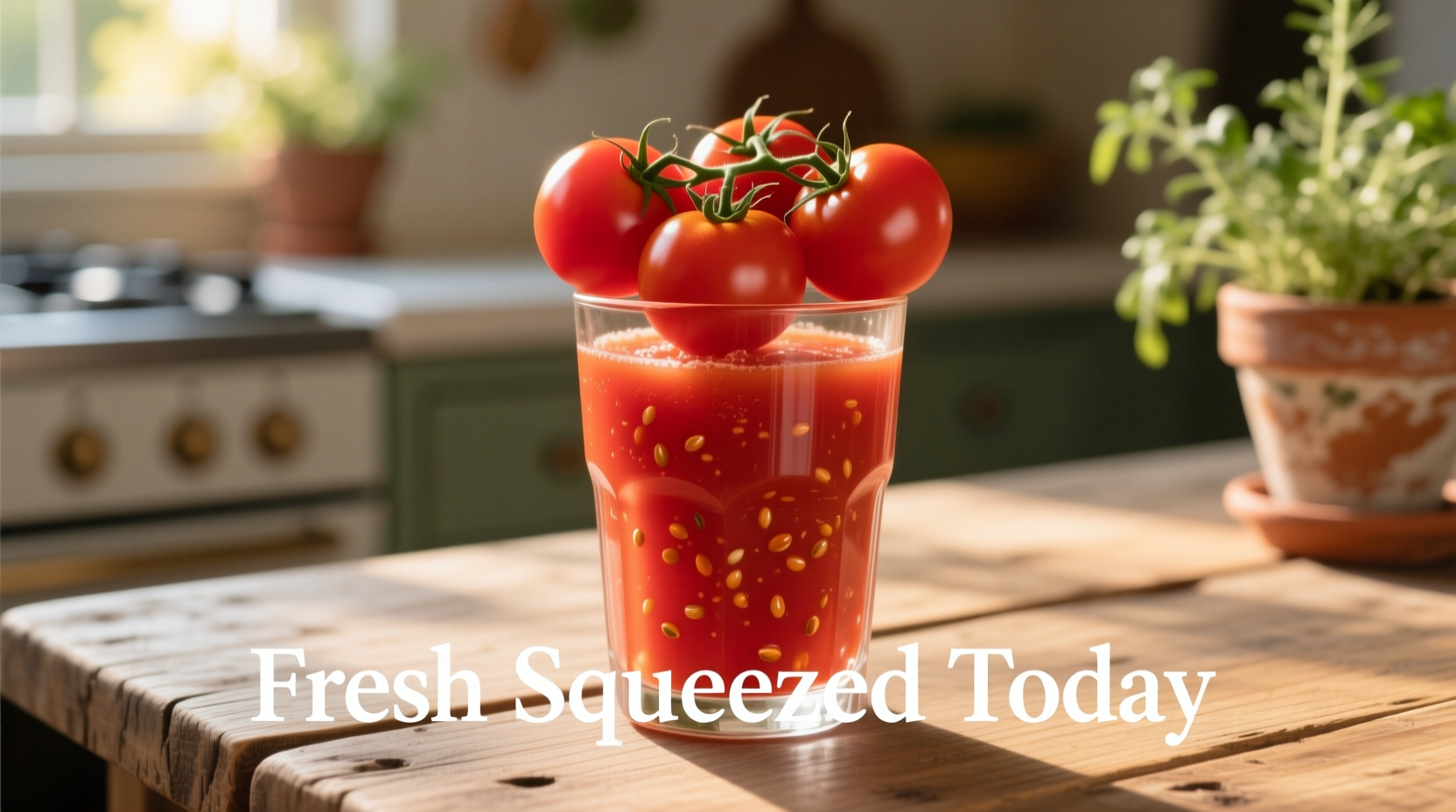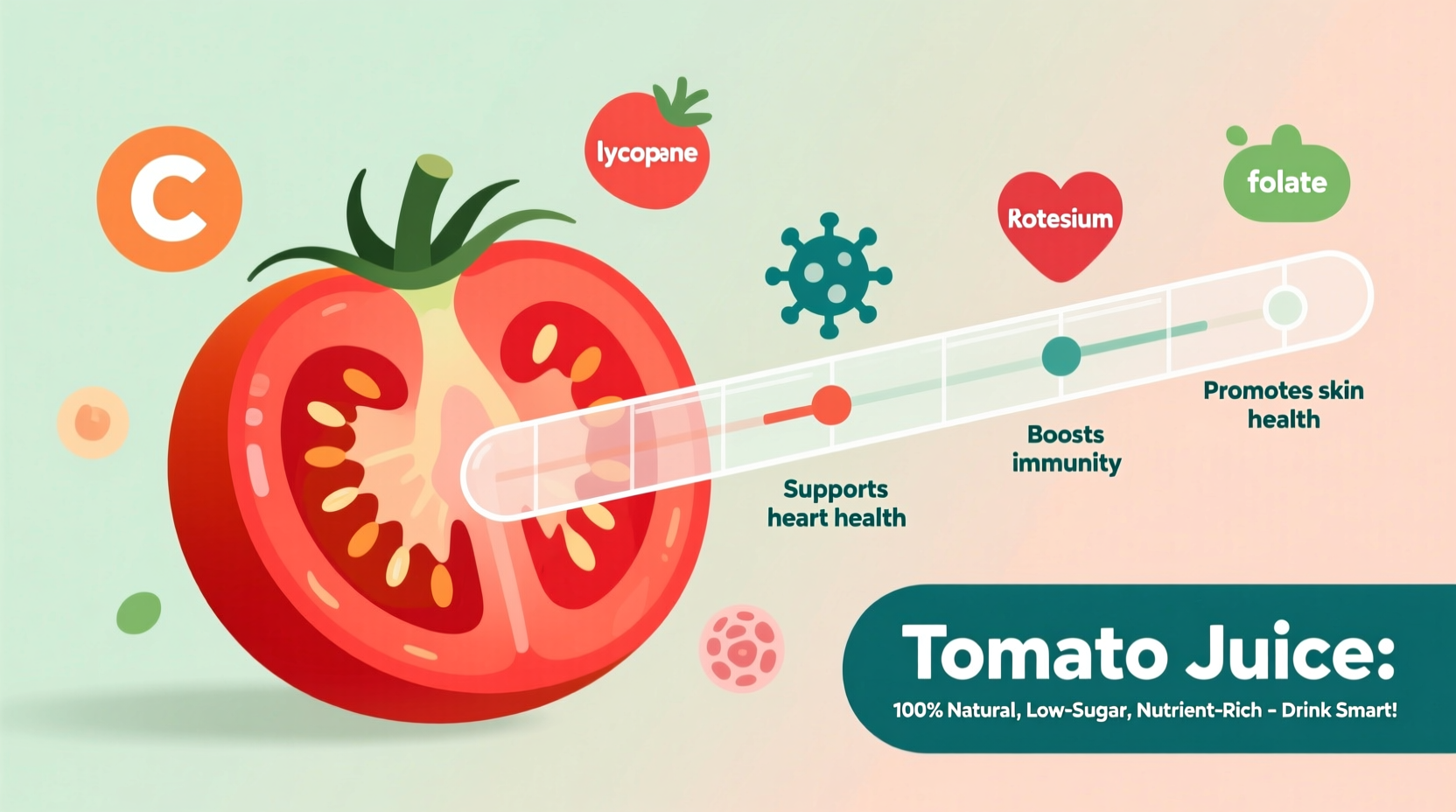Yes, tomato juice is generally healthy when consumed in moderation, providing significant lycopene, vitamins A and C, potassium, and antioxidants. An 8-ounce serving delivers approximately 40% of your daily vitamin C needs and contains 15-20 mg of lycopene—the antioxidant linked to reduced heart disease risk and potential cancer protection. However, commercial varieties often contain added sodium (up to 650mg per serving), and those with kidney issues or on blood thinners should consult doctors due to potassium and vitamin K content.
Tomato juice isn't just another beverage—it's a nutritional powerhouse with science-backed benefits that can transform your daily health routine. Unlike sugary fruit juices, this savory option delivers concentrated lycopene, the red pigment with 48% higher bioavailability when processed compared to raw tomatoes (USDA Food Safety and Inspection Service). Whether you're managing blood pressure or seeking cellular protection, understanding how to maximize tomato juice's benefits while avoiding common pitfalls is essential for smart nutrition.
Nutritional Profile: What's Really in Your Glass
Before reaching for that bottle, know exactly what you're consuming. While homemade versions preserve maximum nutrients, store-bought options vary dramatically in composition. The table below compares typical nutritional values per 8-ounce serving:
| Nutrient | Homemade (Unsalted) | Commercial Regular | Low-Sodium Commercial |
|---|---|---|---|
| Calories | 41 kcal | 45 kcal | 43 kcal |
| Sodium | 10 mg | 650 mg | 140 mg |
| Lycopene | 15-20 mg | 10-15 mg | 12-18 mg |
| Vitamin C | 38% DV | 40% DV | 39% DV |
| Potassium | 12% DV | 11% DV | 12% DV |
Data sourced from USDA FoodData Central (2023) shows that processing tomatoes actually increases lycopene availability while reducing vitamin C content by approximately 10% compared to raw tomatoes. The key differentiator? Sodium levels. Many commercial brands add salt as a preservative, potentially undermining cardiovascular benefits.
Science-Backed Health Benefits You Can Trust

Cardiovascular Protection Through Multiple Pathways
Research published in the American Journal of Hypertension demonstrates that daily tomato juice consumption reduces both systolic and diastolic blood pressure within eight weeks. The mechanism involves:
- Potassium's counteraction of sodium's effects on blood vessels
- Lycopene's inhibition of LDL cholesterol oxidation
- Vitamin C's support of endothelial function
The American Heart Association recognizes tomato products as part of heart-healthy dietary patterns, noting that populations consuming tomato-rich diets show 26% lower cardiovascular mortality rates (AHA Scientific Statement, 2022).
Cancer Risk Reduction: Separating Hype from Evidence
While sensational headlines often overstate benefits, credible research reveals nuanced protection. The National Cancer Institute acknowledges lycopene's role in potentially reducing prostate cancer risk, with observational studies showing 15-20% lower incidence among men with high tomato product consumption. However, they emphasize that tomato juice alone cannot prevent cancer—it works as part of comprehensive lifestyle approaches.
When Tomato Juice Might Not Be Ideal: Critical Context
Despite its benefits, tomato juice isn't universally appropriate. Understanding these context boundaries prevents potential health issues:
Medication Interactions You Should Know
The vitamin K content in tomato juice (approximately 8mcg per 8oz) can interfere with blood thinners like warfarin. Unlike leafy greens with highly variable vitamin K levels, tomato juice offers more consistent amounts, but patients should maintain consistent consumption patterns and consult their healthcare provider. The FDA's Drug-Nutrient Interaction Guidelines specifically note this consideration for anticoagulant therapy.
Acid Sensitivity Considerations
With a pH of 4.1-4.6, tomato juice may exacerbate symptoms for individuals with GERD or gastric ulcers. The International Foundation for Gastrointestinal Disorders recommends those with acid sensitivity choose low-acid varieties or consume tomato juice with meals to minimize irritation.
Maximizing Benefits: Your Practical Consumption Guide
Choosing the Right Product
Not all tomato juices deliver equal benefits. Follow this decision framework:
- Check sodium content: Opt for varieties with ≤140mg per serving (meets FDA's 'low sodium' definition)
- Avoid added sugars: Many 'vegetable juice' blends contain hidden sugars—check ingredients for cane juice or corn syrup
- Consider lycopene boosters: Products containing a small amount of healthy fat (like olive oil) enhance lycopene absorption by up to 40% (Journal of Nutrition, 2021)
Optimal Timing and Pairing Strategies
Maximize nutrient absorption with these evidence-based approaches:
- With healthy fats: Consume with avocado or nuts to increase lycopene absorption
- Morning consumption: Aligns with natural cortisol rhythms for better nutrient utilization
- Avoid calcium supplements within 2 hours—calcium competes with lycopene for absorption
Tomato Juice vs. Whole Tomatoes: Making the Right Choice
While convenient, tomato juice lacks the 2.5g of fiber found in two medium raw tomatoes. This difference matters for blood sugar management and gut health. However, the processing increases lycopene bioavailability by 300-400% according to research from Ohio State University. The solution? Combine both: enjoy tomato juice for lycopene benefits while eating whole tomatoes for fiber.
Evolution of Lycopene Science: A Research Timeline
Our understanding of tomato juice benefits has evolved significantly through rigorous scientific investigation:
- 1980s: Researchers first identify lycopene as tomatoes' primary carotenoid
- 1995: Harvard's Health Professionals Study links tomato consumption to reduced prostate cancer risk
- 2006: FDA permits qualified health claim: 'Very limited and preliminary scientific research suggests that consumption of tomato products may reduce the risk of prostate cancer'
- 2017: NIH-funded research confirms lycopene's role in reducing oxidative stress markers by 25%
- 2023: Current research focuses on lycopene metabolites and their specific cellular mechanisms
This progression demonstrates how initial observational findings have matured into mechanistic understanding, moving beyond correlation to causation in specific biological pathways.
Your Action Plan for Healthy Consumption
Implement these evidence-based strategies immediately:
- Start small: Begin with 4 ounces daily to assess tolerance
- Make it a habit: Pair with breakfast for consistent morning consumption
- Boost absorption: Add 1 teaspoon of extra virgin olive oil to your glass
- Monitor sodium: If using commercial brands, choose low-sodium options and track your daily intake
- Rotate varieties: Alternate between regular, low-sodium, and vegetable-blend options for diverse phytonutrients
Remember that tomato juice complements—but doesn't replace—whole food sources. For optimal health, incorporate both into your diet while maintaining overall dietary balance.











 浙公网安备
33010002000092号
浙公网安备
33010002000092号 浙B2-20120091-4
浙B2-20120091-4